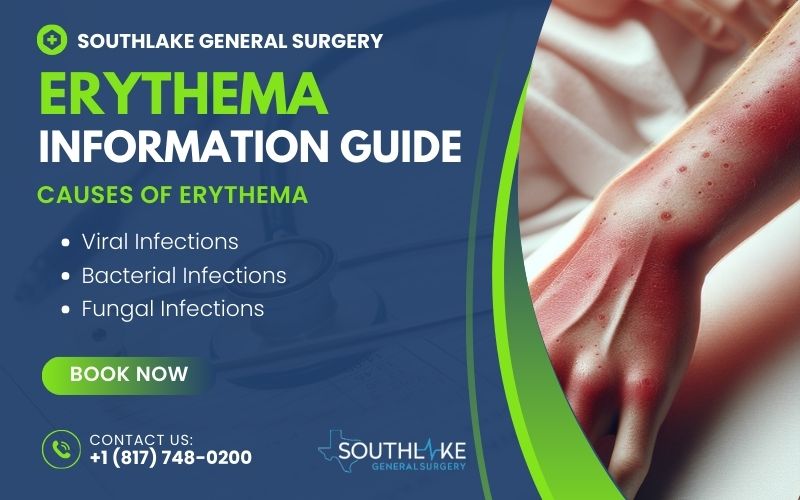Erythema occurs when your skin becomes red due to increased blood flow to the surface. This is different from a quick blush. A skin reaction or irritation might take a bit more time to resolve.
In some uncommon situations, it might indicate potential health concerns, such as rheumatic fever, lupus, or fifth disease.
Erythema shows up as skin lesions that may be either flat or raised. It’s possible that you might experience some itching, burning, or discomfort. Erythema is often caused by inflammation.
Key Highlights
- Erythema refers to the redness that appears on the skin. This occurs when there is an increase in blood flow to that area. This can often indicate a range of health concerns.
- It could look like a flat or swollen rash. At times, you might experience some itching or discomfort.
- There are two primary types of erythema: erythema multiforme and erythema nodosum.
- There are a few factors that can lead to this, such as infections like the herpes simplex virus, allergies to certain medications, and autoimmune issues.
- The underlying reason will determine the treatment. Dealing with the root cause and alleviating the symptoms may be part of the solution.
What is Erythema
Erythema refers to the redness of the skin. This redness occurs when the blood vessels close to the skin’s surface expand. It can happen in different areas of the body, such as the extremities and genitals.
There are two main forms: erythema multiforme minor and erythema multiforme major. It’s helpful to be aware of these types, as they can lead to a mild rash or eruption accompanied by redness.
Keep in mind that erythema simply refers to redness. A rash refers to any visible change in the color or texture of the skin.
The duration it lasts can vary as well. At times, it may only last for a few hours. At times, it may stick around for weeks, months, or even longer.
Skin inflammation can cause erythema, which refers to the redness of the skin. When the body faces an injury, infection, or irritants, it increases blood flow to the area that needs attention.
The increased blood flow can make the skin look red. There are several factors that can contribute to this inflammation, including sun exposure, allergies, and various health concerns.
Erythema can appear in various forms. It may impact a single area or extend to various parts of the body. The redness may appear flat or have a bumpy texture.
It’s possible to observe additional symptoms such as itching, burning, warmth, or swelling. These signs can assist us in grasping the underlying cause.
Types of Erythema Explained
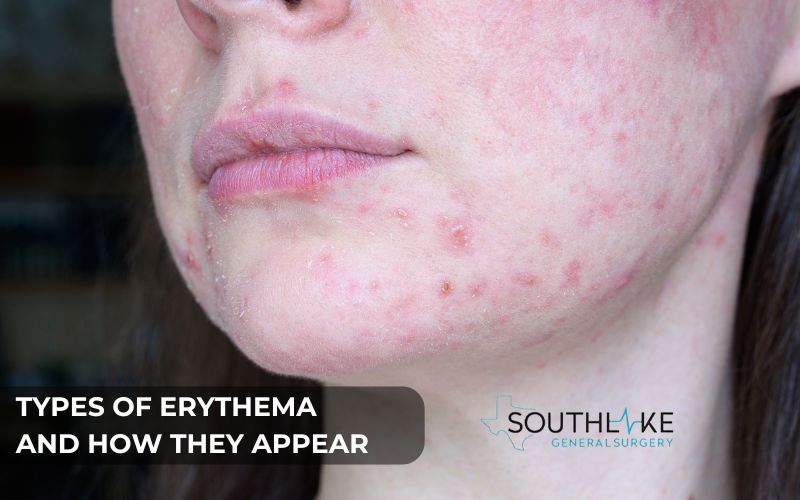
Erythema has various types to explore. Each kind has its unique characteristics. Here are a few of the most typical kinds for you to peruse!
- Erythema Multiforme: This type is commonly linked to infections, particularly those caused by the herpes simplex virus (HSV). It appears as spots resembling targets on the arms and legs. These areas feature red rings surrounding a blister in the center.
- Erythema Nodosum: This condition shows up as painful red lumps beneath the skin, primarily on the shins. It can occur due to reactions to medications, infections, or other inflammatory issues.
- Erythema Migrans: This is commonly observed in the early stages of Lyme disease. A red rash is developing and expanding around the site of a tick bite. The middle of the rash may clear up, creating a shape that resembles a “bull’s-eye.”
Causes of Erythema
Erythema can happen for a variety of reasons. It can often be caused by simple things, such as spending too much time in the sun or experiencing a mild allergy. However, it could also suggest a more significant health concern.
Infectious Agents Leading to Erythema
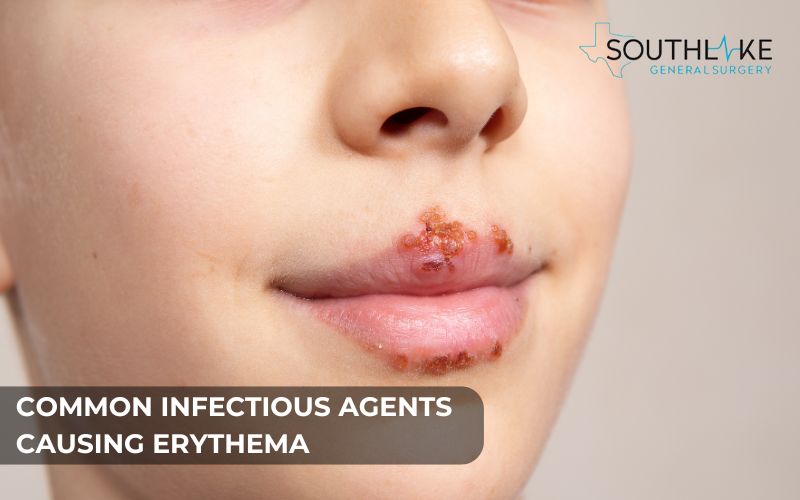
There are various germs that can lead to erythema. Viral infections may result in erythema multiforme. This is commonly associated with the herpes simplex virus (HSV). Erythema multiforme appears as a rash featuring target-shaped spots.
Bacterial infections, such as those caused by Mycoplasma pneumoniae, can lead to breathing difficulties. These can also lead to skin redness in addition to breathing issues.
Fungal infections are far less common than bacterial or viral infections. Even so, they have the potential to bring on redness. When conditions are warm and humid, these diseases thrive. Moreover, they can irritate and inflame the skin, nails, and mucous membranes.
Chemical and Physical Triggers
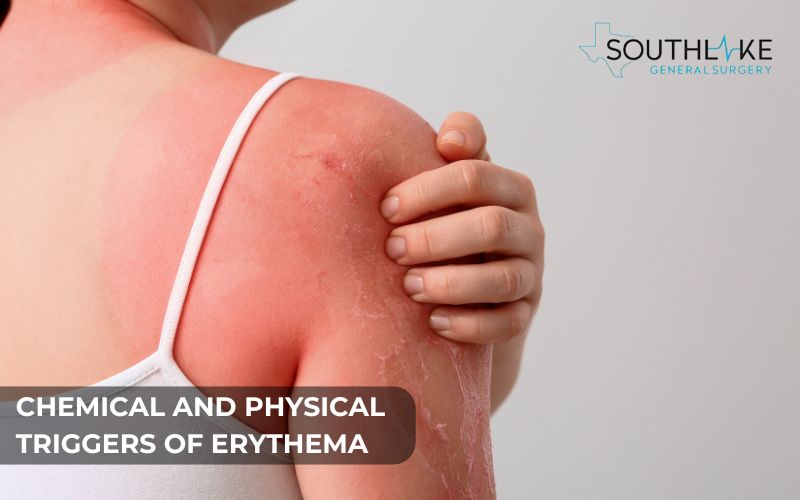
There are other causes of erythema than infection-related irritation. A variety of physical and chemical variables may also come into play.
Dermatitis caused by allergic contact can occur after coming into touch with irritants such as some plants or powerful cleaning chemicals. A reddening, itchy, and blistering skin condition is known as erythema.
Physical irritation can lead to redness of the skin, known as erythema. For instance, when you rub clothes against your skin or apply pressure for an extended period, it can lead to some issues. One well-known type of erythema is sunburn. This occurs when you are exposed to excessive sunlight or UV rays.
Paying attention to potential causes of skin problems is important! If you find that certain things frequently cause redness on your skin, it might be a good idea to reduce your exposure to them.
Recognizing Erythema Symptoms
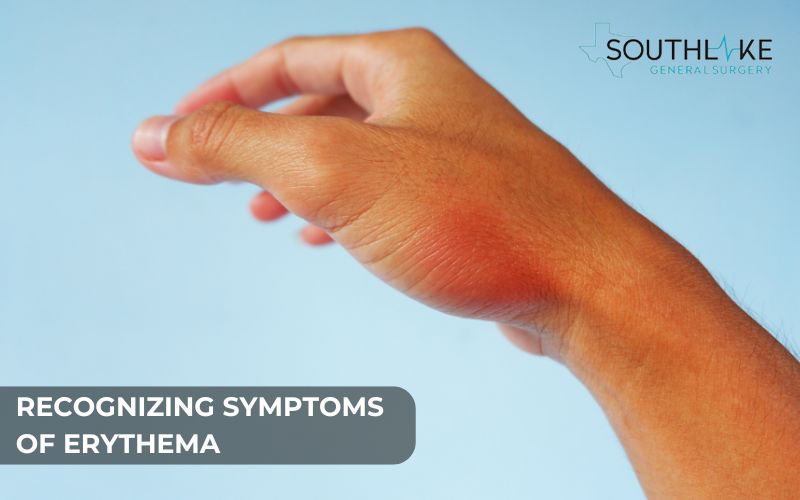
It’s essential to be aware of the signs of erythema for effective diagnosis and treatment. The primary indicator is redness. Exploring additional symptoms can really enhance your understanding.
Common Signs Across Different Types
Erythema typically presents as redness, but it can also manifest in other forms. You may see it appearing as red spots, a larger red patch, or small red dots.
At times, you might notice that the redness becomes more pronounced when you press on it or if there’s a change in temperature. Erythema can present with various signs, not just redness.
Erythema usually shows up as redness, but it can also appear in different ways. It might show up as red spots, a bigger red patch, or tiny red dots.
Sometimes, you may observe that the redness appears more intense when you apply pressure to it or if there’s a shift in temperature. Erythema can show up in different ways, not just as redness.
In many instances, redness tends to improve on its own or can be easily addressed with products available at your local store. If you observe a fever, blisters, or sores containing pus, it is advisable to seek medical consultation.
You should get medical attention immediately if you see that the redness is getting worse. These signs could indicate that there might be something more serious happening.
When to Seek Medical Advice
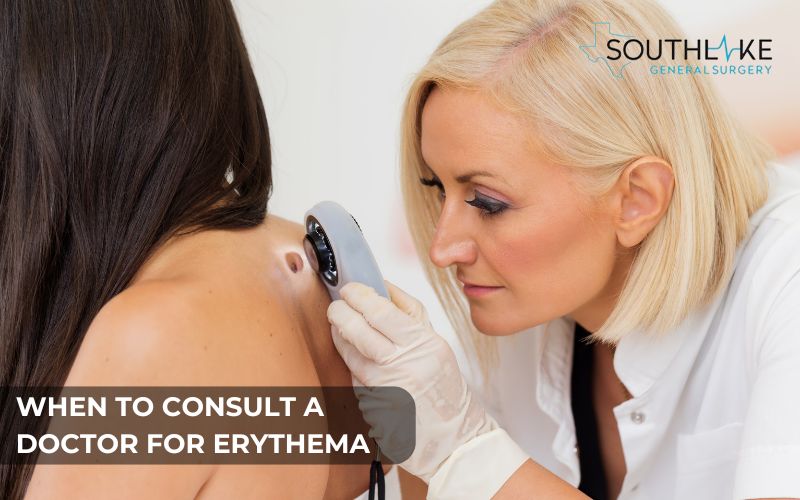
In most instances, redness is not something to worry about. They typically resolve on their own. However, there are specific cases that necessitate prompt medical intervention.
If you notice that the redness is spreading quickly, covering a large area, or not improving after a few days, it’s probably time to consult a doctor.
- People facing health challenges, such as diabetes or a weakened immune system, should take extra precautions.
- Minor changes in the skin might indicate more significant concerns.
- If someone has severe redness, blisters, fever, or indications of infection, get medical attention immediately. Hospitalization for antibiotics or other particular treatments may be necessary.
Diagnostic Approaches for Erythema on Skin
Diagnosing erythema includes a few important steps.
Initial Assessment and History-Taking
When doctors notice redness, they begin by determining the cause. Step one is a thorough evaluation of the patient’s medical history. This assists in gaining a clearer understanding of the patient’s symptoms.
The doctor will inquire about the redness you’re experiencing. People will be curious about when it began and how long it has been around. Here are a few questions that your doctor might ask:
- When did you first notice the redness?
- Has it been updated or relocated since that time?
- Are you taking any kind of supplement or medicine right now? If so, which ones?
- Have you been on any trips recently or come across anyone showing similar signs?
Gathering information about the patient’s health, daily activities, and any potential exposures assists the doctor in identifying the possible reasons for the redness. A physical checkup, combined with this information, can be helpful in figuring out the issue.
Laboratory Tests and Skin Biopsy

For an accurate diagnosis of erythema and to gain insight into its causes, it’s essential to consider lab tests and a skin biopsy. The lab tests could involve the following:
- Blood tests are important for detecting diseases such as the herpes simplex virus and mycoplasma pneumonia.
- Skin biopsies are often recommended by doctors to thoroughly investigate skin irritation. Useful for determining the kind, such as erythema nodosum or multiforme.
These tests are useful for diagnosing various skin issues and developing an appropriate treatment strategy.
In more complicated cases, when symptoms could be similar to those of other autoimmune diseases or skin conditions, this can be very beneficial. For optimal treatment, it is critical to see a doctor and get these tests done.
Treatment Options for Erythema Skin Condition
Treatment for erythema varies based on its underlying cause. In various cases, addressing the problem—such as discontinuing a medication or staying away from an irritant— can help it disappear.
Sometimes redness persists for a longer period of time, and you could need specific treatments. Medications or topical creams might be used for these purposes. They either combat infections, help to lower swelling, or quiet an active immune response.
Home Care and Lifestyle Adjustments

There are several things you can do around the house and in your daily life to alleviate erythema symptoms and speed up the healing process. The afflicted region must be always kept clean and dry. Staying damp may aggravate inflammation and hinder the healing process.
- Gently wash the area with lukewarm water and a gentle, fragrance-free soap.
- To keep the skin from getting worse, don’t use harsh scrubs, hot water, or scented products.
- To reduce swelling and discomfort, try using a cold compress on the affected area.
- Wear loose-fitting, breathable clothing crafted from natural fabrics, such as cotton. The combination of less friction and sweating makes it easier for the skin to breathe and recover.
Medications and Topical Treatments
Healthcare providers might recommend medications or creams to help treat erythema. The seriousness of the disease and the factors that contribute to it will determine the course of treatment.
Topical corticosteroids are commonly found in various forms like creams, ointments, and lotions, and many people use them. These can be helpful in minimizing inflammation and alleviating itching.
When dealing with a bacterial infection, doctors often prescribe antibiotics to assist in your recovery. If you have a viral infection, antiviral medicines may be necessary to help you recover.
When someone experiences an allergic reaction, taking oral antihistamines can be a helpful way to relieve itching and swelling.
If you notice erythema in sensitive areas like the eyes, using eye drops can be a helpful solution. Corticosteroids or antihistamines in the drops can be really helpful in reducing inflammation and itching.
Be sure to follow your doctor’s guidance on the appropriate amount to use and the duration of use.
Preventative Measures for Erythema Disease
Implementing measures to prevent erythema is essential. People who get flare-ups often will find this important. Identifying the triggers of flare-ups and avoiding them is the most effective preventive measure.
It is important to carefully review product labels if you have sensitivities to specific ingredients. Selecting hypoallergenic products may reduce your likelihood of experiencing an allergic reaction.
Avoiding Known Triggers
People experiencing erythema should identify the underlying causes of their condition and take steps to avoid them. It is essential to avoid any medications or skincare products that have previously resulted in adverse reactions.
Dietary options may contribute to exacerbations. Many individuals experience increased sensitivity following the consumption of spicy foods, alcoholic beverages, or specific additives. Maintaining a food diary can be beneficial. This can assist in identifying which foods may be triggering your flare-ups.
To protect your skin from irritation, it is advisable to steer clear of extreme temperatures. Wearing protective clothing while outdoors can significantly benefit your skin health. Utilizing sunscreen is a prudent choice. It provides essential protection for your skin against harmful UV rays.
Skin Care and Protection
A proper skincare regimen is essential for maintaining skin health and minimizing redness. Use gentle cleansers that are in harmony with the pH level of your skin. Avoid using harsh soaps. This practice will assist in maintaining the integrity of your skin’s barrier.
Keeping your skin moisturized is really important! It’s ideal to do it after you’ve had a shower or bath. This is great for bringing back lost moisture and ensuring your skin stays hydrated. Select moisturizers that are free of fragrances and suitable for sensitive skin types. This may help lessen irritation.
Protecting your skin from sun exposure is crucial to prevent irritation and redness. Every day, you should put on a broad-spectrum sunscreen with at least 30 SPF. This remains accurate, even in overcast conditions.
Applying sunscreen is essential for safeguarding your skin against damaging UV radiation. These rays have the potential to cause redness and inflammation.
Living with Erythema Skin Disease
Most of the redness typically resolves rapidly and is not prolonged. However, if an individual experiences persistent redness or if it does not subside, it may impact their overall well-being and daily activities.
In these circumstances, it is beneficial to explore methods for managing the situation and seeking assistance from others.
Engaging in candid discussions with healthcare providers is crucial. It would be to your advantage to learn more about your illness.
Exploring treatment options provides you with a broader range of choices. This can empower individuals and enhance their quality of life.
Managing Symptoms and Flares
Effective management of erythema requires a well-structured approach. An organized plan can alleviate symptoms and lessen the intensity of flare-ups. It is essential to recognize and steer clear of potential triggers. Triggers may include environmental factors, particular foods, or specific products.
- Use cool clothes to affected areas during flare-ups. This alleviates itching, burning, and discomfort.
- Ensure your skin remains hydrated by using lotions or creams that are free from strong fragrances or potential allergens. It helps restore the skin’s protective barrier and minimizes dryness.
- Address issues that result in redness, including autoimmune conditions. Adhere to the prescribed medications, implement necessary lifestyle modifications, and ensure you attend your routine appointments.
Emotional and Psychological Support
Erythema appears on areas of your skin that are typically exposed. This can influence your feelings, particularly for young adults, especially when it relates to a rare condition.
It’s completely normal to feel a bit self-conscious or frustrated at times, and you may even find yourself wanting some space from others. It’s essential to recognize that the mental and emotional effects are just as significant as addressing the physical signs.
- Engaging in open conversations with peers and healthcare providers can foster a sense of support.
- Participating in support groups or online forums can connect you with others who experience erythema. This fosters a supportive environment for sharing personal experiences.
- Engaging in activities that promote relaxation, such as meditation, yoga, or immersing oneself in nature, can be beneficial in managing flare-ups.
Emotional stress can really impact your well-being. That’s why discovering ways to unwind is so essential! Don’t forget, reaching out for assistance shows your strength. This can also assist you on your journey with erythema.
Conclusion
Erythema can occur for a variety of reasons, including infections or exposure to certain chemicals. It can show up in various forms, including erythema multiforme and erythema nodosum. Understanding the signs, causes, and care for this condition is essential for those affected by it.
Erythema can happen for several reasons, such as infections or contact with specific chemicals. It can appear in different ways, such as erythema multiforme and erythema nodosum. It’s important for those affected by this condition to understand the signs, causes, and how to care for it.
Taking care of your emotional well-being and maintaining a good skincare routine are essential when dealing with erythema. Keep in mind that each person experiences erythema differently. It’s important to have various approaches to manage and care for it effectively.
Make an Appointment
If you’re worried about erythema, it’s a great idea to see Dr. Valeria Simone, MD. She is currently at Southlake General Surgery located in Texas, USA.
Dr. Simone is here to share some useful tips on how to check and manage erythema and its related issues.
To schedule an appointment, feel free to give us a call on +1 (817) 748-0200. Dr. Simone brings a wealth of experience and expertise in addressing a variety of skin concerns. She is a trustworthy choice for all your skin care needs.
Frequently Asked Questions
What is the difference between erythema and a rash?
The medical term for redness is erythema. It looks like a rash. The appearance of redness, or erythema, is indicative of a rash. Still, redness is not universal across rashes. Rashes can alter the skin’s color, texture, and overall appearance. Redness is a hallmark of erythema, making it unique.
How is erythema different from other skin conditions?
Red skin is referred to as erythema. While other skin conditions, such as eczema or psoriasis, can also cause redness, this one is different. An immunological response is the one responsible for erythema. Inflammation, allergies, or infections are common triggers for this reaction.
Medically Reviewed By: Dr. Valeria Simone MD
Board-certified General Surgeon at Southlake General Surgery, Texas, USA.
Follow us on Facebook and YouTube.
References:
- Hafsi, Wissem, and Talel Badri. “Erythema Multiforme.” StatPearls – NCBI Bookshelf, 27 May 2023, https://www.ncbi.nlm.nih.gov/books/NBK470259
- Owolabi, Timothy, and Isac Simpson. “An Annular Rash.” AAFP, 1 Apr. 2014, www.aafp.org/afp/2014/0401/p581.html.
- Trayes, Kathryn P., et al. “Erythema Multiforme: Recognition and Management.” AAFP, 15 July 2019, https://www.aafp.org/afp/2019/0715/p82.html
- Huff, J. Clark, et al. “Erythema multiforme: A critical review of characteristics, diagnostic criteria, and causes.” Journal of the American Academy of Dermatology, vol. 8, no. 6, June 1983, pp. 763–75. https://doi.org/10.1016/s0190-9622(83)80003-6.
- “Erythema Multiforme: Recognition and Management.” AAFP, 15 July 2019, https://www.aafp.org/pubs/afp/issues/2019/0715/p82.html
- Lerch, Marianne, et al. “Current Perspectives on Erythema Multiforme.” Clinical Reviews in Allergy & Immunology, vol. 54, no. 1, Jan. 2018, pp. 177–84. https://doi.org/10.1007/s12016-017-8667-7.
- Requena, Luis, and Evaristo Sánchez Yus. “Erythema Nodosum.” Dermatologic Clinics, vol. 26, no. 4, Oct. 2008, pp. 425–38. https://doi.org/10.1016/j.det.2008.05.014.
- Soares A, Sokumbi O. Recent Updates in the Treatment of Erythema Multiforme. Medicina (Kaunas). 2021 Sep 1;57(9):921. doi: 10.3390/medicina57090921. PMID: 34577844; PMCID: PMC8467974.

